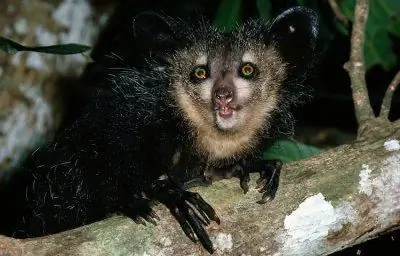- Author Henry Conors [email protected].
- Public 2024-02-12 02:46.
- Last modified 2025-01-23 09:07.
Nature's sense of humor can only be envied. Sometimes she manages to combine incompatible elements in one animal. Can you imagine a mixture of mole and kangaroo? A sort of little underground dweller with a bag on his belly.

View description
Marsupial moles are absolutely amazing animals. They live only in Australia and belong to the genus of marsupial mammals. The genus cannot boast of an extensive list of representatives. It consists of two kinds of animals:
- Notoryctes typhlops, which means the actual marsupial mole.
- Notoryctes caurinus, that is, the northern marsupial mole.
The first species was described in 1889, and the second - relatively recently, in 1920. There are no big differences between species. The northern marsupial is somewhat smaller. An analogue of the marsupial mole is the African golden mole. But, despite the fact that the animals are very similar, they are not related species. This similarity is called convergence. This term describes an evolutionary process that allows similar environmental conditions to influence the appearance of organisms belonging to different systematic groups.
Australia is a unique continent that has preservedmany endemics. Marsupial moles are also endemic, since they are not found in other territories. These animals on the mainland occupy the ecological niche of ordinary moles, which are completely absent in this area.

What does marsupial mole look like
Small animals lead mainly an underground lifestyle, which could not but affect their appearance. The body of animals is quite strong, somewhat valky, that is, smoothly tapering towards the tail. The tail itself has a conical shape, and its length does not exceed 3 cm. The size of the animal is small, a maximum of 18 cm. It remains to find out what is the largest mass of the marsupial mole. The largest specimen that fell into people's hands weighed only 70 g, the smallest - 40 g.
The animal has a short neck, which consists of five fused vertebrae. In the course of natural selection, it was necessary to increase the patency of the animal; for this, the stiffness of the neck was strengthened by nature. The small tail is also hard, there are ring scales on it, and the tip is keratinized. Marsupial moles have five-fingered paws, but the fingers and claws are unevenly developed. To make it more convenient for animals to dig passages, the 3rd and 4th fingers end in large triangular claws. The animal uses its hind legs to push back dug soil, so the claws on them are flatter.
The skin of marsupial baby is soft and thick. It can be white, light brown and golden. Since the sand of the deserts of Australia is rich in iron, the color of the fur can be slightly reddish.
How the nose andeyes
Marsupial moles have a small cone-shaped head with a dense horny shield. This device covers the nose, allowing you to tear the sand with your muzzle. The nostrils look like small slits, and the eyes are generally underdeveloped as unnecessary. In their structure, there is no lens and pupil, and the optic nerve is a vestige. But the lacrimal glands play a significant role: they abundantly moisten the nasal cavity and prevent it from clogging with earth.

How the bag works
There is a special small skin pocket on the abdomen of the animal. This is a brood bag designed for feeding small and very underdeveloped cubs. In marsupial moles, this adaptation is somewhat different than in other species. It opens back so that sand does not get inside. Inside there is an incomplete partition. Each "pocket" of the brood pouch contains one nipple. Males also have a small transverse fold on their belly, which is a vestige of the brood pouch.
Lifestyle
Now you have an idea what the marsupial mole looks like. It remains to find out how he lives. Animals are found in the sandy deserts of Western Australia and in the northern territory. Favorite places are dunes and river dunes.
The animal digs deep holes only during the breeding season. The rest of the time he spends under the sandy surface. In the course of the movement of the marsupial mole, the tunnels do not remain, since the sand does not hold its shape well. But on the surface of the sand a kind of triple track is visible. The marsupial mole moves with an amazingspeed. It is difficult to catch him, as the animal burrows very quickly.

Moles live one by one. They are active both during the day and at night. They rarely come to the surface, usually after rain.
The reproduction of these animal species has not been studied. It is almost impossible to observe them in natural conditions, and in captivity they do not live long. The offspring of females appears in deep holes. Most likely, there are 2 babies in the litter (since the bag has 2 pockets). The average lifespan of a marsupial mole is about one and a half years.
Food
The marsupial mole, the photo of which can be seen in our article, has a good appetite. The animal spends most of its time looking for a source of food. It can be aboveground and underground insects, worms and larvae. Animals often feed on ant pupae. Sometimes more substantial prey is eaten - small lizards.
Marsupial moles are recognized as an endangered species. They were listed in the Red Book to create conditions for the conservation and study of animals.






